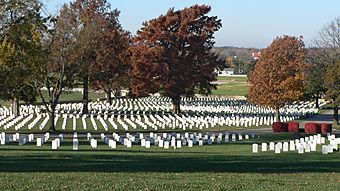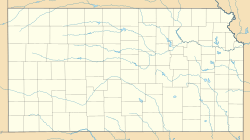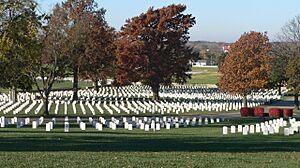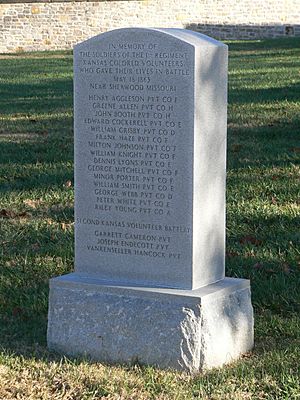Fort Scott National Cemetery facts for kids
Quick facts for kids |
|
|
Fort Scott National Historic Site
|
|
 |
|
| Location | 900 East National Ave., Fort Scott, Kansas |
|---|---|
| Area | 6.7 acres (2.7 ha) |
| Built | 1842 |
| NRHP reference No. | 66000106 |
| Added to NRHP | October 15, 1966 |
Fort Scott National Cemetery is a special place in Fort Scott, Kansas. It is a United States National Cemetery, which means it's a burial ground for military veterans and their families. The United States Department of Veterans Affairs manages this cemetery.
It covers about 21.8 acres of land. As of 2021, more than 8,000 people have been buried there. Fort Scott National Cemetery is one of only three national cemeteries located in Kansas. The other two are Fort Leavenworth and Leavenworth.
Contents
History of Fort Scott National Cemetery
How the Cemetery Started
Fort Scott was built in 1842. It was located on an important route called Military Road. This road connected Fort Leavenworth in Kansas to Fort Gibson, Oklahoma. The fort was named after Lieutenant General Winfield Scott, a famous military leader.
When the fort was first built, a small area on its west side was used as a cemetery. Later, in 1861, a new piece of land was bought for burials. This new area was called Presbyterian Graveyard because the Presbyterian Church took care of it.
The Civil War and National Cemetery Status
During the American Civil War, many soldiers died in battles nearby. The Presbyterian Graveyard was used to bury these soldiers. On November 15, 1862, this plot of land became Fort Scott National Cemetery.
It was one of the first twelve United States National Cemeteries ever created. President Abraham Lincoln himself chose these original cemeteries. Fort Scott National Cemetery is even listed as U.S. National Cemetery #1, which is a very special honor!
Burials from Other Places
After the Civil War ended, the burials from the original fort cemetery were moved to the new National Cemetery. Also, after the American Indian Wars, many frontier forts were closed. Their cemeteries were then moved to Fort Scott National Cemetery. This includes burials from places like Fort Lincoln.
The cemetery also holds the graves of two Royal Canadian Air Force officers. They died during World War II and are remembered by the Commonwealth War Graves Commission.
In 1999, Fort Scott National Cemetery was added to the National Register of Historic Places. This means it's recognized as an important historical site.
Commemorative Monuments
Eugene Fitch Ware's Unique Grave
A large, natural sandstone boulder marks the grave of Eugene Fitch Ware and his wife, Jeannette Huntington Ware. Eugene Ware fought in the Union Army during the Civil War. He eventually became a captain.
After the war, he became a lawyer and served in the Kansas state legislature. He was also a well-known author and poet. He wrote under the pen name "Ironquill." Before he passed away in 1911, he asked for this beautiful boulder to be his grave marker.
First Kansas Colored Volunteers Monument
A gray granite monument honors the First Kansas Colored Volunteer Infantry. This regiment was based at Fort Scott during the Civil War. It was formed as a Kansas state unit in August 1862.
The regiment officially joined the federal service in January 1863, after the Emancipation Proclamation. This monument lists the names of soldiers from the regiment. These brave soldiers died in a battle near Sherwood, Missouri, on May 18, 1863.





